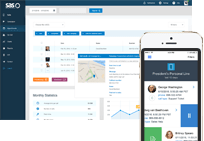- Log In
- Support
- Company
- Contact Us
- Live answers @ 1-888-532-4794
7 Must Do Answering Service Hacks

The first couple of days (or weeks) after hiring an answering service can be a challenge. Not only do you have a new communication channel to keep track of, but you also have a whole new team of virtual employees who are answering your calls – which of course you want to go perfectly. On top of all of that, you have a business to run. How the heck do you manage it all?!
Since we’re experts on all things answering service, we created a quick 7 point guide to help you out, young grasshopper. Read on to learn what to do after you’ve hired an answering service, so that your transition can be as seamless as possible.
#1. Know your forwarding number
In general, telephone answering services work on the principle of call forwarding. They provide you with a designated phone number at the call center, and you forward your office phones to that number when you want the answering service to handle your calls. Typically, you have the option of advertising that number separately (so calls will go direct to the service), forwarding your current lines to it (where you decide when the answering service is handling your calls), or both! Whichever method you choose, it’s important that you keep that number handy so you or anyone in your office can route calls to the answering service. Write the number down and stick it to your computer, save it in a word document, or tattoo it on your hand. Whatever will help you remember it best!
#2. Contact your phone provider
Once you’ve signed up with an answering service, you’ll want to touch base with your phone provider. If you’re not sure how to forward calls, they can help you. If you don’t have call forwarding on your business phone, they can help you with that too. You can also discuss with them the different forwarding methods they offer and what would be the best option for your business. For example, conditional call forwarding would allow calls to come to you first before routing over to your service. This way you have the opportunity to answer them before anyone else. Another option would be all calls call forwarding, which just sends your calls directly to the number you’ve forwarded to. This option would be great during after hours, weekends and holidays so that there is no wait time for your callers. Keep in mind that not all phone providers offer these options, which is why it’s important to touch base with them early on.
#3. Make test calls
Assuming that you’ve already given your new answering service the protocol on how you want your calls handled, the next thing you’ll want to do is make test calls to see how they’re handling those protocols. Think of this like training a new employee you would hire in your own office. You’ll want to see how the new employee handles calls, and you’ll probably end up adjusting some of your protocols to get the most out of your new hire. Virtual receptionists operate with the same learning curve. So you aren’t paying for that learning curve, typically services will offer some sort of free trial period, so it’s a great idea to make all of your test calls during this phase. That way you can iron out any kinks you may come across, and you won’t have to pay for the calls you’ve made. Often times people will go right to forwarding their lines before making any test calls, which could result in a lot of errors and unhappy clients.
Pro tip: It’s important to keep in mind that the operators may make mistakes during the beginning stages as they are still learning your account. Using any free trial period to make test calls will give the operators ample time to learn your protocol, so that when you are finally ready to go live with your callers, you can feel confident that the hand off will be smooth.
#4. Modify your call handling
After a few test calls, you may find that the way the receptionists are handling your calls isn’t 100% what you had envisioned. Sometimes what works best for handling calls in your own office isn’t what works best for a virtual receptionist answering your calls. Make a list of all the changes or modifications you would like, and submit them to the appropriate point of contact as one list. If your service allows you to access this information via an online portal, you can even try making the changes yourself! Another great way to make tweaks is by listening to calls. If your service records phone calls, you can get a lot of great insight into what your callers are asking about or looking for. This is a great opportunity to add FAQs and update your call handling accordingly, so that your calls are as streamlined as possible and there is less for you to follow up on.
#5. Know your points of contact
It’s important to know who your points of contact are at the answering service. Is there a customer support team? Do you have one specific account representative? Are you able to call your forwarding number directly and have the operators make changes? These are all great questions to ask your service provider so that you know exactly who to call whenever you need assistance. If you have to go through a customer support rep, you should also find out when they are available, and if there’s a protocol you can follow should you need immediate help after hours. For example, Specialty Answering Service gives all of our per minute level clients access to an online portal where they can log in and make updates at a moment’s notice. While we do offer support after hours, it can be limited so it’s always a great idea to get familiar with the tools that are at your disposal!
#6. Go live!
Now that you’ve memorized your new number, got your forwarding procedure squared away with your phone provider, placed test calls and made the appropriate changes to your script, you are ready to go live with your customers. After you’ve forwarded your line, make one last test call from a different phone, like your cell phone, just to ensure that you’re properly forwarded, then you’ll be free to handle business as normal, just without all the interruptions!
Pro tip: Letting your customers know in advance that you will be utilizing an answering service could be beneficial to both you and your service. If your callers are used to speaking with the same people every time they call, they may be put off when they start to hear new voices. In addition, it’s a great opportunity to ask for feedback, which you can then relay to your service. After all, feedback (whether good or bad) is always helpful in the end.
#7. Don’t forget to check in
It’s always a good idea to check in on your answering service every month or so to make sure things are still running smoothly. Some people will let their account go for months, or years, without ever making updates. While this isn’t necessarily a bad thing (if it ain’t broke, don’t fix it, right?), it’s important to keep in mind that the virtual receptionists are your virtual employees, and employees need direction. For example if your prices increased, you’ll want to make sure your answering service is aware of that, or else the operators will be providing inaccurate information to your callers.
Categories
- Advice (32)
- Answering Service 101 (18)
- Best Practices (10)
- Call Center Jobs (6)
- Call Center Software (20)
- Comparison (2)
- Customer Service (30)
- Funny (31)
- Holidays (19)
- Industry Hacks (19)
- Infographics (53)
- International (1)
- Medical (8)
- News (12)
- Phone Etiquette (2)
- Phones (14)
- Pricing (8)
- Quizzes (3)
- Receptionist (11)
- SAS Products (29)
- Scripting (4)
- Services (5)
- Small Business (25)
- Starting Up (7)
- Tips and Tricks (19)
- Uncategorized (1)
- Videos (19)
- Workplace (6)
Recently writen
- Call Center Script Best Practices: Advanced Script Block Tips to Optimize Your Answering Service
- January 2025 Release Notes – Adjustments to Call Details Timeline, New Scripting Updates, Live Transcription, and more!
- April 2024 Release Notes – Voicemail Greetings, Ability to Access Websites With a Username and Password, and more!
- March 2024 Release Notes – New Add-On, Settings Revamp, and more!
Follow Us
How about a demo?
We'll show you how our web portal works and answer any questions you have about SAS.
Schedule a demo







